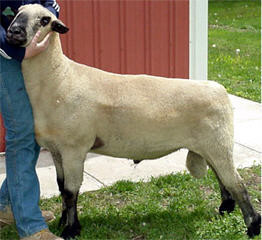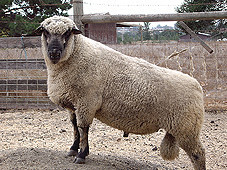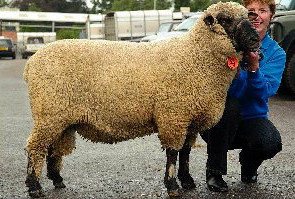<!--<!--<!--<!--
 Shropshire
Shropshire
Sheep breed facts:
The Shropshire sheep is another of Britain’s sheep breeds that has been around for many years. It is a short-woolled ‘Down’ breed as opposed to a ‘hill’ breed and its native area is the most northerly of the Down breeds. The Shropshire Down is promoted as a breed ‘from the past – for the future’.
Like many of Britain’s old breeds, its origins are clouded in mystery but it seems that the native sheep on the Staffordshire/Shropshire/ Worcestershire borders were ‘improved’ during the early part of the 19th century. The indigenous sheep were tough and hardy with good resistance to footrot and scab. However while the fleeces were of a high quality, they weighed only a kilo or so. Also the sheep were slow to reach a marketable weight.
George Adney selectively bred within the breed for good conformation without sacrificing the Shropshire’s innate toughness. On the other hand, Samuel Miere introduced infusions of Southdown blood (which eliminated the horns of the original Shropshire) then Leicester blood to improve the docility of the breed.
Significant dates and facts
1838 Royal Agricultural Society of England founded, annual shows organised
1845 No class for Shropshires at Shrewsbury annual show but several rams displayed
1853 Royal Show at Gloucester – classes for ‘Shropshires, or other grey or black-faced shortwools’.
c.1855 First imports into Virginia, USA
1860 Shropshires given their own classes, carcass weight has doubled and fleece weight increased from 1kg to around 3kg. A ram and twenty ewes imported into Maryland, USA
1880 Shropshires represented in farm flocks in most American colonies
1882 Earliest records of the Shropshire Sheep Breeders’ Association and Flock Book Society
1883 Shropshire Flock book first such publication for a sheep breed
1884 Shrewsbury Royal Show – 875 Shropshires exhibited against 420 other distinct breeds. Sixty exhibitors from fifteen counties were represented.
1880 – 1900 253 registered rams exported
Mid 1890s Shropshire Breed Societies formed in South Australia and Tasmania
1903 600 Shropshire rams sold in Victoria, Australia at Royal Melbourne Show Sales
carcasses sired by Shropshires
1900 – 1920 6,700 rams exported, mainly to Australia, New Zealand, South Africa and America. Soon breeders were importing pedigree rams back into Britain. There were dramatic changes in the air however. The outbreak of war disrupted trade and shipping. Financial constraints meant housewives were looking for smaller cuts of meat, and there was a foot and mouth outbreak. Despite vigorous promotional work by the Flock Book Society, by 1973 there were only seven registered flocks and 402 breeding ewes. From this point, fortunes changed somewhat with 78 flocks and 1844 breeding ewes being recorded in 1992.
Description
The Shropshire is of medium size with rams weighing around 120kg and ewes 80kg. The face should be free of wool apart from the poll. There is good width between the ears and the muzzle is short. Legs, ears and face are all soft black in colour. The neck is muscular and wide at the base. The throat should be clean and the body well fleshed and deep. The back is broad and straight with well sprung ribs. The leg of mutton should be full and deep. The legs should be of strong bone and set well apart. The tail is broad and should be set on almost level with the back. The skin is a cherry pink with dense, fine wool. Shropshires are alert and active whilst remaining calm and easy to handle. Undesirable characteristics include white specks on the black areas, horn stubs, Roman (convex) nose, sloping rump and drooping, long, pricked or thick ears.
Fleece weight is 2 to 3 kg with a staple length of 10 to 15cm. The fleece is heavy and dense with a soft handle. It should be virtually free of kemp with no grey or black fibres. The wool is used for hosiery and knitting yarn, worsted fabrics and, more recently, for filling futon beds.


Today’s Shropshire is a true dual purpose animal. The lambs are hardy and meaty, reaching marketable sizes and weights at an early age. Wool production is among the heaviest for medium-wool breeds. However, the Shropshire’s prime use is as a terminal sire for prime lamb production. Apart from having these usual attributes of a dual purpose breed, the Shropshire is also playing an increasing role in controlling herbage in tree plantations and orchards thus reducing the need for chemical control of weeds. Studies have shown that with careful management tree damage is minimal. The animals are relatively low maintenance requiring little care other than the provision of water and mineral licks. New growth may be grazed to the height of the standing sheep but foliage above this level is not touched. Provided the animals are not allowed to become too hungry, there is little damage to the bark.
Such use of the Shropshire augurs well for those engaged in organic projects.
Origins of the breed
The exact origins of today’s Shropshire Down are unclear but generally agreed to be as a result of the improvement of the indigenous sheep of the Staffordshire and Shropshire border areas. These were hardy stock, not prone to footrot or scab, and produced wool of a superior quality. The fleece however only weighed about 2 - 2.5 lbs and the sheep were slow to mature to a suitable butcher’s weight. Following the achievements of stockbreeders such as Robert Bakewell with the rapidly maturing New Leicester and improvements of the Southdown by John Ellman, the sheep of The Long Mynd in Shropshire, Cannock Chase in Staffordshire and Morfe Common on the borders of Shropshire, Staffordshire and Worcestershire became subject to improvement during the first half of the 1800’s. Records indicate that two Shropshire farmers, George Adney and Samuel Miere were instrumental in the long-term development and promotion of the breed.
George Adney improved the local breeds from the Shropshire Hills by retaining those animals that combined their native hardiness with a good conformation without employing rams of other breeds to introduce desirable attributes. In contrast, Samuel Miere continued his father’s work on improving the native Shropshire sheep by introducing the influence of other breeds. As he described in 1858, at a farmers’ club meeting in Shropshire, ‘It is not attempted to be denied that the Shropshire is a cross-bred sheep. The original breed was horned, and the first attempt at improvement was to get rid if these encumbrances, and there is little doubt that this was effected by a cross of the Southdown. This sheep was well adapted for the Downs, but for the enclosures of Shropshire something more docile was required, consequently recourse was had to the Leicester’. And so it was that careful selection of stock resulted in uniformity and the establishment of a superior improved Shropshire Down, which was to make an impact at agricultural shows throughout the country. As previously mentioned a system of pedigree recording and the production of a Flock Book enabled purchasers not only at home, but abroad, to identify reputable breeders. Oversees sales increased and between 1880 and 1900, 253 registered rams were exported. During the next 20 years no fewer than 6700 Shropshire rams left Britain to all continents but mainly to Australia, New Zealand and America. The impact of the Shropshire ram on fat lamb production in these countries is well documented. For example in the early 1900s 70% of lambs exported from Australia were one half or three quarters bred Shropshires. And in America, reflecting the Australian success of Shropshire rams crossed with Merino ewes, a Wyoming farmer commented: ‘The first cross Shropshire on Merino makes a very desirable all-round sheep for this country. They seem to stand such extremes of temperature as we have here at least as well as any other breed.
Such was the export trade that British farmers had come to rely upon these countries for supplementation of imported pedigree stock.
The purebred Shropshire is utilised by Christmas tree growers who, with careful management, value the breed’s ability to graze in conifer plantations without damaging trees. Avoiding the use of chemical weed-killers satisfies the demands of today’s environmentally aware market for which a steady European export trade is being developed.
Today’s breed society continues to promote the Shropshire Down which can be seen exhibited at many major agricultural shows and displayed at the National Sheep Association main sheep promotional events. Come along and see this distinguished breed which has proven itself so many times in the past and continues to do so for today’s market. The Shropshire Down, truly a modern sheep ‘from the past - for the future’.
Shropshire Benefits
Shropshires are gentle in disposition, making them perfect for the farm flock or as a club project for children. The rams have a lean, well-muscled body structure which they transmit to their offspring, making them popular with the commercial as well as the purebred breeder. The ewes are prolific and long-lived with wonderful mothering and milking abilities. There are seldom any lambing problems with Shropshire ewes.
Extremely feed efficient
Prolific mothers
High rates of gain
Meaty carcasses
Medium sized
Multiple births
Longevity
Shown slick sheared
Great youth projects
Official breed description for the Shropshire Down
Official Breed Description
The Shropshire is medium sized, with typical mature rams and ewes weighing 120kg and 80kg respectively. Shropshire Sheep are active and alert with a free action.
Head: Naturally clean soft black face, with a covering of wool on the poll. Rams should possess a bold masculine head.
Ears: Soft black in colour, of medium length, well set on.
Neck: Muscular and not too long.
Body: Well fleshed, long, deep and symmetrical. A broad, straight back with well-sprung ribs. Rump – quarters long and wide, dock well set on and legs of mutton full and deep.
Legs: Medium length, of strong bone and upright joints, well set apart and soft black in colour.
Skin and wool: Cherry pink covered with dense, fine quality wool of good staple.
Undesirable Traits
Horn stubs
White specks on face, ears and legs
Thick, coarse, long, pricked or drooping ears
Coloured wool in the fleece
Drooping rump
Throatiness
Roman nose
Coarse wool on the breeches
BRITISH WOOL MARETING BOARD’S CLASSIFICATION OF SHROPSHIRE WOOL
Wool Classification: Shortwool and Down
Staple Length: 10 to 15cm.
Fleece Weight: 2 to 3kg
Quality: 54s to 56s
Description and Use:
The Shropshire is more completely covered with wool than any other Down breed and grows a particularly heavy, dense fleece. Its wool is fine with a pleasantly soft handle and is almost free from kemp and grey or black fibres. Although frequently used for woollen hosiery and knitting yarns, some Shropshire wool is used for worsted manufacture. Much of it is exported to European countries at the top stage – that is to say, after combing and before spinning. Hand-knitting wools are among the other products for which Shropshire wool is used. There is also considerable demand from Shropshire wool in Japan for filling Futons (sofa-beds).
Commercial opportunities
Flexibility for Flock-Owners
Shropshire sheep adapt to every soil and climate. They flourish throughout the UK, from the English lowlands to the highlands and islands of Scotland. Flocks are also kept successfully in the high rainfall areas of Ireland and at altitudes of more than 300 metres (1000 feet) in the mountainous areas of Wales.
Location(NZ): On all types of country throughout New Zealand in stud, commercial and lifestyle flocks. Excel in producing prime early lambs in dry or drought prone areas such as Hawkes Bay and eastern Wairarapa. One of the most successful crosses is with Merino, where the lambs retain the finer fleece of the Merino whilst growing out quickly in the Shropshire tradition.
Great Prolificacy and Longevity
Shropshire ewes have the ability to lamb early, and regularly achieve lambing percentages (UK)of 160% and above. As dams, Shropshires are docile, milky and rear twin lambs with ease. They are extremely hardy and have a long productive flock life.
Breeding/Lambing (NZ) : 120-160 percent.
Breeding/Lambing (US) : Lambing percentages of 175-200% are not uncommon in a flock of Shropshires.
Easy Care and Thrifty
Shropshires are a relatively easy-care breed, being docile and easy to handle and requiring only minimal routine husbandry in most situations. The breed has a well-proven ability to finish successfully from grass alone.
Top Quality Shropshire Lamb
The Shropshire was developed as a supreme meat breed, and today’s Shropshires retain the ability to produce finished lambs of the highest quality. The breed combines fast growth with excellent carcass traits.
Recent carcass grading figures for a consignment of 22 lambs supplied in the Summer of 2005 to Lloyd Maunder (see below), show the high quality of Shropshire lambs.
After slaughter, the lambs were weighed and then assessed “on the hook” by independent inspectors. Each lamb received a grade for carcase conformation and the level of fat cover. For carcass conformation, there are 5 grades (E, U, R, O and P) where “E” is the best and “P” is the poorest. For fat class, “1” is the leanest and “5” the fattest, with grades 3 and 4 being split into two categories: Light (L) and Heavy (H). Grades 3H up to 5 are generally considered too fat. Fat class 1 is generally considered too lean.

|
SHROPSHIRE LAMB GRADES – SUMMER 2005 |
|
|
Number of lambs |
Conformation and fat class |
|
1 |
E3L |
|
10 |
U3L |
|
5 |
U2 |
|
5 |
R3L |
|
1 |
R2 |
|
Carcase weights ranged from 19.5 to 24.5kg |
|
|
(The above Figures were kindly supplied by SSBA members, John and Pauline Bowles) |
|
 100% of the Shropshire lambs met the supermarket buyers’ specifications for conformation and fat class.
100% of the Shropshire lambs met the supermarket buyers’ specifications for conformation and fat class.
 16 lambs (73%) were classified in the top two grades for conformation, which can be influenced only by breeding
16 lambs (73%) were classified in the top two grades for conformation, which can be influenced only by breeding
 Not one of the lambs was too fat – indeed, 100% achieved the most desirable grades for fat cover.
Not one of the lambs was too fat – indeed, 100% achieved the most desirable grades for fat cover.
By contrast, figures from the English Beef and Lamb Executive (EBLEX) reveal that only 58.9% of lambs in England meet the target grades of E/U/R with a fat cover of 2/3L. On average, some 23.3% of lambs are too fat, and 17.8% have poor conformation.
Excellent Scrapie Resistance
Since the launch of the National Scrapie Plan, nearly 4,500 Shropshires have been genotyped. The breed is completely free from the “V” allele, which is linked to Scrapie susceptibility. According to the latest NSP figures for the breed, and around 60% of animals are Type 1 or Type 2 – the most resistant genotypes.
Bodyweight:
In (UK)
Ewes: 80 kg
Rams: 120 kg

In (NZ)
Ewes: 50-65 kg
Rams: 80-110 kg
In (US)
Ewes: 68-81 kg
Rams: 102-113 kg
Meat: High yielding carcass, ideal for further processing.
Numbers(NZ) : A rare breed in most of the world. Currently fewer than 270 registered ewes in New Zealand, although this is up from a low of 50 registered ewes in 1981/82.
Wool :
Valuable Shropshire Wool
Shropshires produce high fine quality wool of good staple. The sheep have a more complete covering of wool than any other Downland breed, and produce a heavy, dense fleece. Second longest wool staple of all the down breeds.
Fibre diameter: 27-33 microns
Staple length: 65-75 mm
Fleece weight: weighing between 2 and 3.5kg
Uses: suitable for hand knitting and a wide range of other uses ( Knitting yarns and hosiery )



ساحة النقاش